Promoting STEAM education at the primary level
Background
The world is fast-changing and it is important for students to learn to adapt to whatever the future holds. To nurture future-ready learners, we can integrate STEAM education into language education for developing students' language-related knowledge and skills through engaging them in hands-on and minds-on STEAM activities while simultaneously strengthening their critical thinking and problem solving skills. As many STEAM activities involve solving real-life issues and problems, by engaging students in addressing them, they can nurture proper values and attitudes such as empathy and a desire to promote the well-being of themselves and others. Recognising this, SKH Lui Ming Choi Memorial Primary School introduces STEAM education early at KS1 in order to lay a solid foundation for the development of generic and 21st century skills and inquiry thinking at later key stages. Sharing the same belief, the English teachers infuse elements of STEAM education into the school English Language curriculum. They aim to engage students in exploration of knowledge and experimentation with innovative ideas so as to reinforce their subject-specific knowledge alongside enhancing their English-related knowledge and skills, and cultivate their critical thinking skills, problem solving skills and proper values and attitudes, thereby preparing them to embrace change.
The English teachers piloted STEM education in P3 in 2021/22. In response to the major renewed emphases stated in Primary Education Curriculum Guide (Pilot Version) released in 2022, they took a step forward to add elements of visual arts and language arts into some of their STEAM-infused modules in P2 and P3 in the 2022/23 and 2023/24 s.y.. This report illustrates how STEAM education was implemented in the school using two of the P2 modules designed by the English teachers.
Level
P2
Strategies used
The following strategies were adopted to facilitate the planning and implementation of the STEAM-infused modules:
Strategies |
Objectives |
Details |
|
|
|
|
|
|
|
|
|
What happened
-
Mapping the curriculum of the English Language subject and other subjects
As STEAM education involves the application of subject-specific knowledge, English teachers conducted curriculum mapping with teachers of other subjects including non-language subjects to select appropriate themes for the modules. Apart from mapping relevant themes, the teaching schedule of the subjects involved was synchronised as much as possible to facilitate making connections across subjects by students.
The table below summarises the key features concerning different subjects of the two P2 modules implemented in the English lessons:
Module 1 |
Module 2 |
|
Themes |
Healthy eating |
Together we are very strong |
Key messages |
We should have a balanced diet and should not be picky eaters who only eat tasty but unhealthy food. |
Our family members work hard. We should understand and appreciate their hard work and work hand in hand to keep our flat clean and tidy. |
Content knowledge introduced/ reinforced |
|
|
English-related learning objectives |
|
|
STEAM activities |
Oil level test |
Paper stand design |
Strategies |
POE |
Design Thinking |
Generic skills |
Thinking skills |
Thinking and problem solving skills |
Priority values |
Empathy, benevolence |
Empathy, benevolence, unity |
*The theme-related subject-specific knowledge was also reinforced in the Chinese, Putonghua and Library lessons.
-
Selecting and designing theme-related learning materials for contextualisation and teaching of subject-specific and English-related knowledge
Theme-related reading materials, introduced by theme-related characters such as a nurse and an old man, were used to spark students' interest in reading. In the first module, a nurse who promoted healthy eating among students shared the healthy and unhealthy food posters she made to reinforce the healthy and unhealthy food taught in the General Studies and English lessons. In the second module, an old man who was too tired and weak to do housework alone shared his story, which is also a well-known fable called "The Old Man and His Son". The fable not only brought out the priority value, unity, but also paved the way for the teaching of the science behind the structure of a bundle of sticks. In both modules, the reading materials gave students an opportunity to consolidate the use of the simple present tense and "there is/are". They also gave students a sound reason to find out more about healthy eating and strong structures in the subsequent STEAM activities. |
 |
Apart from reading materials, other theme and daily life-related materials were selected. In the second module, for instance, everyday examples such as paper tube chairs, honeycomb chairs and honeycomb wrapping paper were shared to explain the concept "Together we are very strong". Students reinforced their knowledge of strong structures and saw the relevance and importance of the science concept in their daily life. |  Using food posters and a fable for contextualisation and knowledge building |
|
|
|
Using everyday examples to explain the concept of "Together we are very strong"
-
Connecting learning of English and subject-specific knowledge for the promotion of STEAM education
The reading texts used for introducing and reinforcing subject-specific knowledge was also employed to teach and reinforce reading skills. For example, in the second module, the teachers demonstrated how to work out the meaning of unfamiliar words in the fable "The Old Man and His Son" by using the strategy of highlighting. Keywords in the text (e.g. bundle) and relevant pictures were circled in the fable, as a scaffolding strategy, for students to work out word meanings. Then students read other texts – a photo of a paper tube chair and honeycomb chair and its caption – to practise and consolidate the strategy. Alongside reading skills development, students' knowledge of strong structures was reinforced through the reading texts. For instance, they tried to figure out why the paper tube chair and honeycomb chair could withstand heavy weight by applying their knowledge of strong structures, paving the way for the subsequent paper stand STEAM activity.
-
Using STEAM activities to solve daily-life problems
STEAM activities were used to help students solve daily-life problems. The first module was implemented around the Chinese New Year. Students read a text on Chinese New Year food. To show empathy and benevolence to students who put on a lot of weight or got sick after eating too much unhealthy festival food, they did an oil level test using the POE strategy, explored knowledge by themselves, and gave advice on how to eat healthily during Chinese New Year.
|
|
|
P: Predicting if steamed or fried turnip cakes is healthier
O: Observing the amount of oil absorbed by kitchen paper
E: Drawing a conclusion and justifying it based on the amount of oil absorbed
|
|
Applying knowledge of healthy eating in the oil level test
In the second module, students connected the world of the fable, "The Old Man and His Sons", with their own world. They learnt the moral of the fable "Together we are very strong" and realised it was everyone's responsibility to keep his/her flat tidy and when family members worked hand in hand, they could greatly relieve their parents' workload. As books, clothes and toys lying all over the place after their examinations is a common problem among students, they designed a paper stand for putting things neatly. In this activity, "Together we are very strong" is a moral as well as a science concept presented in a student-friendly language. Students were engaged in the design thinking process to apply their knowledge of strong structures for making a sturdy paper stand.

Design Thinking introduced in a student-friendly language
|
|
|
Test 1: Making and testing a paper stand with one cylinder |
Tests 2 & 3: Finding out why one cylinder failed to withstand the weight of a book and suggesting creative ideas to solve the problem with peers |
Applying Visual Arts knowledge by choosing a warm or cool colour their parents like for their paper stands |
-
Assessing student learning in the STEAM-infused modules
A variety of assessment strategies was adopted to track student learning progress in the STEAM-infused modules. Emphasis was placed on both the learning process and learning outcomes.
For science tests such as the oil level test in the first module, the teachers observed if students were able to make predictions, record findings of the test, draw conclusions and give sensible, informed advice. In the second module, as the design of a prototype/product was involved, students were assessed on whether they were able to improve their design using the target STEAM-related knowledge and skills (e.g. adding prisms and counting extra prisms needed to make their paper stand stronger).
Language-related assessments include observing if students could apply the target language and vocabulary items in the STEAM activities, such as using "There is/are" and cardinal numbers to describe the number of tubes or prisms used to make paper stands. Students' progress in the target reading skills was tracked by analysing their scores in a reading pre-test and an identical post-test. It helped teachers identify those reading skills students needed to work further on and take the necessary action to support them.
In both modules, student underwent a self-reflection process. Before students took on the role of a little nurse or little designer, they reflected on if they were benevolent (i.e. caring, helpful and kind). After completing the STEAM activities, which involved group collaboration, they looked back at their learning experiences, reflected on whether they were helpful and supportive when they were taking part in the activities, and assessed themselves on the same priority value again.
Impact
Curriculum development
A variety of learning materials, including language arts texts (e.g. a fable) and English texts on subject-specific knowledge (e.g. healthy eating) was drawn upon to teach English-related knowledge and skills and subject-specific knowledge in English. This paved the way for students to explore the world of STEAM education and enhance their thinking and problem solving skills through actively engaging themselves in exploration of new knowledge and experimentation with innovative ideas.
Student learning
From improving one's knowledge and skills to enhancing quality of life
The STEAM activities gave students hands-on and minds-on learning experiences to develop their thinking and problem solving skills. Young as they are, they demonstrated their abilities to explore new knowledge and experiment with innovative ideas as they took part in both activities. In the oil level test, they were able to predict the oil level in fried and steamed turnip cakes, observe and record the test findings, explain the results and draw a conclusion sensibly and in an informed manner. Through the paper stand activity, students developed their problem solving skills. They tested the strength of their paper stand and suggested creative ideas (e.g. adding more prisms and layers) to solve the problems they had encountered through reviewing their work critically by themselves and with peers.
In the learning process, students also reinforced the target language and vocabulary items. In the oil level test, students could use the simple present tense to talk about their learning (e.g. "Steamed turnip cake is healthy."). In the paper stand activity, they could apply the target language and vocabulary (e.g. using "There is/are", vocabulary about numbers and 3D shapes to describe their paper stand). After implementing the two modules, a post-reading test was conducted and students from all proficiency groups showed improvement in the mastery of the target reading skills.
Apart from knowledge and skills, most important of all, the learning experiences enabled students to see how STEAM-related knowledge could solve everyday problems and make their life better (e.g. suggesting how to eat healthily and how to make their home a better place to live in), thereby promoting the well-being of themselves and others.

Students making predictions, observing and explaining the results in the oil level test
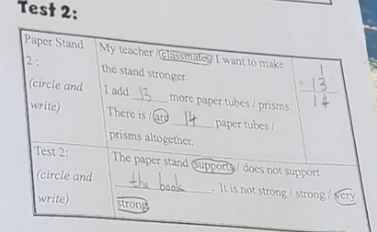 |
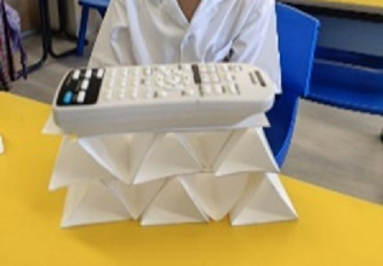 |
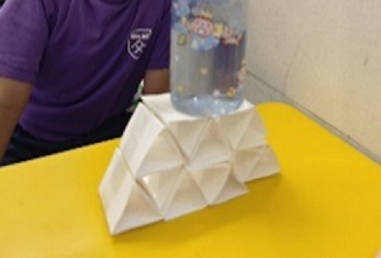 |
Applying Mathematics knowledge and consolidating vocabulary about numbers and 3D shapes in the design process |
Testing and perfecting their paper stands by adding more prisms and layers |
|
Promoting a culture of self-reflection among students
Ample opportunities were given to students for putting into practice and reflecting upon the target priority value before and after the STEAM activities. For example, before they took part in the paper stand design activity, they assessed themselves to get a better understanding of their own perception of their level of benevolence. Then they took on the role of a little designer and put into practice the target priority value by helping one another to overcome the problems encountered in the design process. Afterwards, they reviewed the learning process and completed a post-activity self-reflection form to assess themselves on the same priority value. A similar self-reflection cycle was promoted in almost all the P2 and P3 STEAM-infused modules to foster a culture of self-reflection among students.
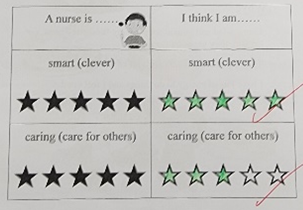 |
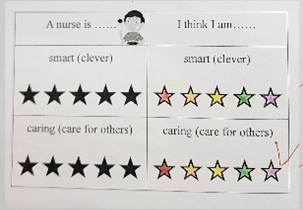 |
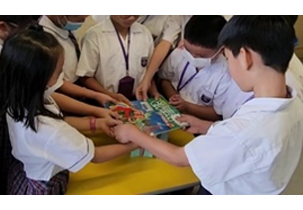 |
Pre-activity self-reflection |
Post-activity self-reflection |
Showing kindness and helpfulness in solving the problems encountered in the design thinking process |
|
Teachers' professional development |
The P2 English teachers working hand in hand to promote STEAM education |
Conclusion
Facilitating factors
- STEAM made fun and easy for young learners
STEAM education was successfully implemented in P2. Students took part in the lessons enthusiastically and completed the learning activities smoothly. This was largely attributable to the strategies adopted by the English teachers to enhance the motivation of and cater for the needs of the young learners:
To improve students' engagement, the teachers used different characters (e.g. the old man) for contextualisation of the modules. Also, students showed active participation in the STEAM activities as they were assigned a well-defined role (e.g. a little designer).
The language used in the modules was pitched at the level of P2 students. Simple language was used and complex concepts were put in student-friendly terms.
Used
Instead of
Caring, kind, helpful
Benevolent
Together we are very strong
Together we are stronger
Predict
Hypothesise
A new solution
Ideate
Examples of simple words and expressions used in the modules to cater for P2 students' learning needs
Apart from designing a module booklet for all students, the English teachers also prepared a supplementary booklet to support their learning in their own time. It contains the target language and vocabulary items of the module for students' revision. There are also extended theme-related vocabulary and learning materials on subject-specific knowledge related to the STEAM activities. As teachers observed, the less proficient students focused more on the target language and vocabulary while the more proficient ones tended to explore subject-specific knowledge in English more. The supplementary booklet served as a "buffet" for students to select learning materials to help them with their learning in the module including their learning in the STEAM activities.
Effective use of language arts to promote STEAM education
The letter "A" in "STEAM" refers to the arts including language arts. The experience of this school shows that language arts, when appropriately integrated with other domains in "STEAM", can greatly contribute to the promotion of STEAM education. For instance, by drawing upon the plot and moral of the fable "The Old Man and His Son", the otherwise complex scientific concept related to strong structures was effectively explained to P2 students. By connecting the scientific content to a famous story, it sparked students' learning interest and facilitated their learning in the subsequent STEAM activity.
Way forward
With the experience gained, the English teachers were better equipped to support the implementation of STEAM education. More possibilities of implementing STEAM education across subjects will be explored at various levels to further strengthen students' abilities to explore knowledge and experiment with innovative ideas. The teachers will continue to work together to broaden students' knowledge base, improve their English, and cultivate critical thinking skills, problem solving skills and proper values and attitudes among them, getting them ready for the challenges facing them in later key stages.
Bibliography
Curriculum Development Council. (2016). Report on Promotion of STEM Education: Unleashing Potential in Innovation. Retrieved from: https://www.edb.gov.hk/attachment/en/curriculum-development/renewal/Brief%20on%20STEM%20(Overview)_eng_20151105.pdf
Curriculum Development Council. (2024). Primary Education Curriculum Guide. Retrieved from: https://www.edb.gov.hk/attachment/tc/curriculum-development/major-level-of-edu/primary/curriculum-documents/Primary_Education_Curriculum_Guide/PECG%202024_full.pdf
White, R. T., & Gunstone, R. F. (1992). Probing Understanding. Falmer Press.
SKH Lui Ming Choi Memorial Primary School
Florence YIP (Language Support Officer)











